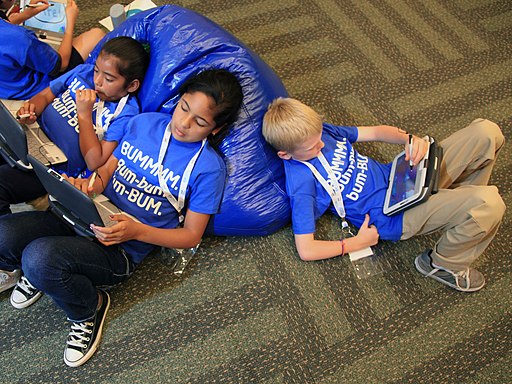Misconceptions about Digital Literacy

As a parent of 3 young children who are growing up in a digital world, I feel completely confident that I have it all under control…displacement of face-to-face interactions and verbal communication, harassment, violence and cyber bullying, exposure to pornography, misinformation, corporate and state surveillance, data mining…exploitation of children, trafficking…I mean, what could possibly go wrong?
There is so much information out there on this digital world but how do we navigate it all? How do we begin to educate ourselves and inform our children on how to safely and effectively navigate this fast paced and ever-changing digital environment? Well, we can at least start here…
5 Misconceptions about Digital Tools and our Youth
1. Privacy settings are all I need to keep my kid safe online.
The best and the worst elements of human nature, knowledge and interactions can be amplified by digital media (Luke, 2018). Mix in ads, redundancies, clutter and corporate agendas, and this can be a lot to navigate safely. So, you may be saying to yourself, as long as I set strict privacy settings on my child’s phone or digital tools, they won’t be in any danger of compromised digital privacy, data mining, harassment etc.…right?
 Wrong. Cyber bullying, exposure to polarizing political views and targeted ads are
all examples of content that can slip through the cracks of privacy settings. Privacy
settings are a good place to start but don’t stop there.
Wrong. Cyber bullying, exposure to polarizing political views and targeted ads are
all examples of content that can slip through the cracks of privacy settings. Privacy
settings are a good place to start but don’t stop there.
We are asked all the time to consent to privacy policies and data sharing policies in order to use digital tools but the Pew Research Center found that 63% of Americans say they do not understand almost anything about the privacy laws that are currently in place to protect our personal information and data (Auxier et. al., 2020).
This article from the NSW Department of Education, gives a wonderful summary of where to start with privacy settings for Facebook, Twitter, Instagram and more, but it neglects to discuss what steps are needed beyond these settings.
Parents, teachers, and mentors need to be active participants in our children’s online actions. We need to check in with our children and educate them about how to tell the difference between friendliness and exploitation, real news and fake news, a person and a bot, and targeted ads and real recommendations, to name a few. If we pay attention and provide our children with the knowledge that they need to safely participate in this ever-changing digital world, we are doing them, and ourselves a favor.
2. Digital literacies are neutral.
Before we debunk this myth, you may be asking what the heck are digital literacies? “The American Library Association refers to digital literacies as ‘the ability to find, evaluate, create, and communicate information, requiring both cognitive and technical skills’ (American Library Association, 2013, p. 2). In other words, the ways people communicate, create and collaborate with digital tools, which requires cognitive but also technical skills (Castek & Gwinn, 2020).
We must understand and teach our children that all of these new ways of engaging with digital literacies are, by nature, motivated. It may be a bully motivated to shame someone with less power, it may be a political organization trying to spread misinformation, or it may be a large tech company trying to mine data and present targeted ads to a specific group. Corporate interests are not your child’s interests.
As consumers in a commercial world and as young minds in a polarized political scene, we need to train our youth to be wary of ulterior motives and hidden agendas and be cognizant of the “political economy of communications” (Luke, 2018, p. 193). Intentional and unintentional consequences result from each interaction with digital tools and these interactions are a part of a mostly invisible ecosystemic system of exchanges (Luke, 2018).
We need to teach and promote digital citizenship and encourage our youth to be critical evaluators of all digital literacies (Luke, 2018).
 3. Schools teach my child all they need to know about digital footprints.
3. Schools teach my child all they need to know about digital footprints.
You may think when you send your students to school, they are going to be taught how to navigate this evolving world of digital literacy but in fact, it has not been widely integrated into most curricula in an intentional way. My daughters attended virtual school for about a year and a half collectively and while they were learning something, a short intro on netiquette was as far as the teachers went to prepare my girls for navigating this new technological classroom. There was no instruction on searching things on Google (which was available on their Chromebooks) or messaging friends on Teams.
How do I know this?
I was listening. The whole time while I worked from home, much like many parents were doing during this time, I was listening. Let me be clear that this was in no way entirely the teacher’s fault. Teachers were just surviving, minute to minute, day to day, trying to make sense of their new digital classrooms.
Fast forward two years to when most students are back in a face-to-face setting and the districts have still not send out information regarding digital footprints, instructions on how to make sure your child is informed and aware of the consequences that one YouTube video, or one social media post, can have. I would like to see training on how our youth are to make informed decisions in the digital world built into the curriculum. This pedagogic responsibility is a job for the districts...and it is long overdue.
4. Equity issues don’t matter as long as you have equal access.
Schools do their best to provide equal access to students in a school setting but if those students aren’t equipped with the knowledge of how to safely and effectively use those tools, there can be a disparity between different groups of students. For example, an English-language learner (ELL) may have access to the computer lab like all of the other students in their class but a language barrier can prevent a student from using that technology effectively.
Digital ethics needs to be a term that we use often at home and teach in our schools. Groups in rural or remote areas, indigenous peoples and economically marginalized communities may have restricted access to digital tools at home and in schools. Even if they do have the same tools (sometimes homeless youth use smart phones as cultural currency in their communities, Ford, 2018), they may lack equitable education on how to safely and effectively engage with these tools.
5. My child can differentiate between real news and fake news.
You may think that your child will be able to recognize information that is not based in fact, but the truth is, it’s hard enough for many adults to navigate this challenge much less children (Luke, 2018). Giving our youth the skills to differentiate between what is based in fact and what is not, must be a national priority.
We need policies to be investigated, evaluated, re-instated, and free from private corporate interests. Nepotism within large companies needs to be eradicated and fact-based reporting needs to be an agenda that we all agree on for the sake of ourselves and our future--our youth.
Further Reading
For more on protecting our children from the unintentional consequences of our digital
footprint, check out this school system’s website based out of GA:
https://www.barrow.k12.ga.us/departments/communications/digital-citizenship/digital-footprint-responsibility. They give tips on how to manage your child’s digital footprint and how to clean
up your digital footprint.
For more on digital equity, check out the National Digital Inclusion Alliance (NDIA) community website: https://www.digitalinclusion.org/definitions/. It defines digital literacy, digital equity, digital inclusion, the digital divide, digital foundational skills and more.
This article from Cornell University is a great read if you would like to learn more about disinformation and how to critically evaluate what we read and see on the news everyday: https://guides.library.cornell.edu/evaluate_news
If you are interested in going beyond digital safety, explore ideas in digital citizenship from Dr. Marie Heath: What kind of digital citizen? of our Educational Technology Program.
References
Auxier, B., Rainie, L., Anderson, M., Perrin, A., Kumar, M., & Turner, E. (2020, August 17). Americans and privacy: Concerned, confused and feeling lack of control over their personal information. Pew Research Center: Internet, Science & Tech. Retrieved July 4, 2022, from https://www.pewresearch.org/internet/2019/11/15/americans-and-privacy-concerned-confused-and-feeling-lack-of-control-over-their-personal-information/
Castek, J., & Gwinn, C. B. (2020). Literacy and Leadership in the Digital Age. In Dagen A.S., Bean, R. M. (2020). Best practices of literacy leaders, second edition keys to school improvement (pp. 258-279). Guilford Publications.
Controlling your privacy settings in social media. Digital Citizenship - home. (n.d.). Retrieved July 4, 2022, from https://www.digitalcitizenship.nsw.edu.au/articles/controlling-your-privacy-settings-in-social-media
Ford, C. A., (2018) Equities and Digital Literacies: Issues of Access, Ethics and Engagement in a Youth Community Setting. Language and Literacy. 20(3), 67-72.
Luke, A., (2018) Digital Ethics Now. Language and Literacy. 20(3), 185-198.
About the Author
Johanna Hutchison is a Clinical Liaison at Howard Community College and recently earned the M.Ed. in Teaching Literacy to Culturally and Linguistically Diverse Populations from Loyola University Maryland.